Retro Corner: Goldeneye 007
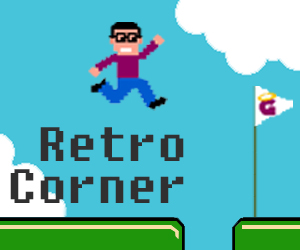 Game: Goldeneye 007 (1997)
Game: Goldeneye 007 (1997)
Developer: RARE
Publisher: Nintendo
Originally Released on: Nintendo 64
Currently Available on: Currently Unavailable
Coming two years after the cinematic release of the film of the same name, few gamers would have expected to see a new James Bond Goldeneye 007 game being lined up for release on the new Nintendo 64 console. Given the rather poor history of film to game adaptations, even fewer gaming fans would have expected the game to not only be a lot of fun, but for the title to change the home console gaming scene forever.
 Whilst First Person Shooters of course made an appearance on home consoles already, the PC was still firmly the platform of choice for shooting fans. The console versions of games such as Doom were always somewhat second rate when compared to the PC ones and consoles couldn’t compete with the large networked multiplayer action that was possible on desktop computers. Multiplayer FPS gaming was a revolution on PC, creating a whole new way to play your games, against a whole host of new opponents. Console gaming hadn’t been able to compete.
Whilst First Person Shooters of course made an appearance on home consoles already, the PC was still firmly the platform of choice for shooting fans. The console versions of games such as Doom were always somewhat second rate when compared to the PC ones and consoles couldn’t compete with the large networked multiplayer action that was possible on desktop computers. Multiplayer FPS gaming was a revolution on PC, creating a whole new way to play your games, against a whole host of new opponents. Console gaming hadn’t been able to compete.
And so it came to be that an unlikely hero, from an unlikely source, would come along to show the world that a multiplayer FPS on home console was possible, and that it could be every bit as good as the rest of the competition. RARE, the UK-based development studio responsible for such titles as Donkey Kong Country and Battletoads, had made their name with platform games and beat-em-ups. This would be their first stab at a FPS, in a market that was already flooded with many shooting titles, which were hoping to be the next Quake. Combine that with the fact that Goldeneye the film performed admirably at the box office, but didn’t blow audiences away, and that most film adaptations rely on the marketing push for the film to help swell sales of the game – whereas this game was following the film by a whole two years – and the signs for success weren’t exactly good.
But what RARE obviously understood was that great level design, interesting objectives and a thoughtful use of the license would still result in a great end result. The game mirrors events from the film surprisngly closely – you could predict most of the mission objectives and even navigate some of the levels a little easier, by possessing a good knowledge of the film. Despite the blocky 3D graphics, the game was an accurate representation of the locations and events seen on the big screen. Face mapping was used to apply semi-realistic (or at least recognisable) likenesses of the actors from the film onto the polygonal character models, and even the guards and NPCs had faces mapped, to give them all their own character and make the overall experience a little more engrossing.
Smoke effects were used to add extra drama and makes the environments more realistic, and bullet holes would appear on surfaces that had been shot – even behind enemies you had just fired at, which was another impressive effect, and on top of that, the game didn’t have to resort to the foggy effect that many N64 games suffered from – in order to cover up poor draw distances. Graphically, the game was more impressive than most of it N64 peers. In terms of audio, the music used throughout was mainly taken from the film, but tweaked and re-worked to fit the levels well – even music created especially for the game fitted well with well-known Bond themes, and really helped add to the atmosphere of the levels. On top of that, many sound effects were found throughout the title, and explosions and shattering glass windows helped add to the overall feeling of great detail in the game.
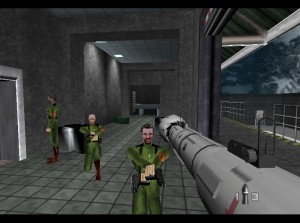 The selection of weapons at your disposal was good and varied (featuring many guns from different entries in the Bond film series, such as the Golden Gun and the Moonraker Laser) and the shooting mechanics were all very solid (the game was in fact one of the first FPS titles to feature a zoomable Sniper Rifle). Different weapons had different rates of fire and armour-piercing abilities, for example, so needed to be employed against the right person at the right time. But what made the levels more unique was the fact that you had to employ certain spy gadgets, such as remote-contolled mines and a laser wrist-watch, in order to complete certain mission objectives. This gave a good amount of variety to the levels, and made sure that they weren’t all simply run and gun affairs. In one particular situation, the player must use the Electromagnetic feature of their watch to steal a cell key, and fashion an escape. The player also got the chance to drive a tank around the streets of St. Petersburg.
The selection of weapons at your disposal was good and varied (featuring many guns from different entries in the Bond film series, such as the Golden Gun and the Moonraker Laser) and the shooting mechanics were all very solid (the game was in fact one of the first FPS titles to feature a zoomable Sniper Rifle). Different weapons had different rates of fire and armour-piercing abilities, for example, so needed to be employed against the right person at the right time. But what made the levels more unique was the fact that you had to employ certain spy gadgets, such as remote-contolled mines and a laser wrist-watch, in order to complete certain mission objectives. This gave a good amount of variety to the levels, and made sure that they weren’t all simply run and gun affairs. In one particular situation, the player must use the Electromagnetic feature of their watch to steal a cell key, and fashion an escape. The player also got the chance to drive a tank around the streets of St. Petersburg.
Unlike many first-person shooting games, the title also encouraged the player to employ stealth tactics throughout many sections of the game. Too many missed shots could alert guards from a distance, and in turn alarms could be set off – whereby the player would be swarmed by more and more reinforcements. In order to be more like a Spy, and to be Bond, players could utilise silenced weapons and it was advisable to shoot security cameras whenever you spotted one, so that the alarm wouldn’t be raised that way. You could even make use of a Karate Chop melee attack, but this was risky as it wouldn’t finish off all enemies with a single blow.
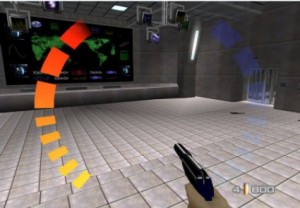 The game featured three distinct difficulty levels. I say distinct, as not only did the amount of enemies, cleverness of the AI and the amount of health that those enemies possessed increase as the difficulties rose, but extra objectives would be added at higher levels. For example, perhaps on “Agent” difficulty, a player simply needed to escape the level. On “Secret Agent”, they would need to disable all alarms before escaping, and on “00-Agent” however, they would have to intercept some top secret information and then complete all previous objectives as well. This made playing the game again very enjoyable, as levels could become quite different when you stepped up the difficulty, and you would be forced to play the level in a different way than perhaps you did when it was on an easy setting. When the player had successfully completed the hardest difficulty level, “007” difficulty became available, where the player could customise sliders to alter the difficulty of a stage to their own liking. This sliding difficulty scale was a very good learning curve, and meant the game could be enjoyed by all levels of gamer, no matter their FPS ability. Being so all-inclusive meant the game appealed to a wider audience than some shooters, and it attracted a much more casual audience than games such as Quake.
The game featured three distinct difficulty levels. I say distinct, as not only did the amount of enemies, cleverness of the AI and the amount of health that those enemies possessed increase as the difficulties rose, but extra objectives would be added at higher levels. For example, perhaps on “Agent” difficulty, a player simply needed to escape the level. On “Secret Agent”, they would need to disable all alarms before escaping, and on “00-Agent” however, they would have to intercept some top secret information and then complete all previous objectives as well. This made playing the game again very enjoyable, as levels could become quite different when you stepped up the difficulty, and you would be forced to play the level in a different way than perhaps you did when it was on an easy setting. When the player had successfully completed the hardest difficulty level, “007” difficulty became available, where the player could customise sliders to alter the difficulty of a stage to their own liking. This sliding difficulty scale was a very good learning curve, and meant the game could be enjoyed by all levels of gamer, no matter their FPS ability. Being so all-inclusive meant the game appealed to a wider audience than some shooters, and it attracted a much more casual audience than games such as Quake.
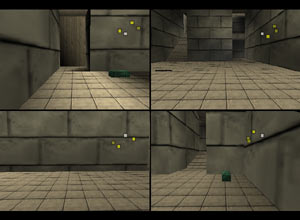 But when you talk about Goldeneye on the Nintendo 64, what immediately comes to mind is the four-player multiplayer mode. The Nintendo 64 was the first mainstream games console to come equipped with four controller ports built-in, and therefore the console lent itself to being the platform for quick and easy party play. Despite the fact that Designer for the title Davad Doak has since stated that the multiplayer mode was added on to the game at the last minute, the game soon became the number one multiplayer title on the console. Two to four players could face off in a great variety of modes, across split-screens. Regular Deathmatch and team-based were present, as well as a variety of Bond-themed modes. You only live twice gave players two lives for the whole round – featuring full health bars and armour capabilities, but only one respawn. License to Kill, conversely allowed infinite respawns, but players had no energy and could be killed with a single shot – this led to really frantic and knife-edge battles. The Living Daylights was a capture the flag mode, and The Man with the Golden Gun placed said weapon in the level, allowing whomever possessed it to cause huge damage to enemies, until another player could kill them and take the gun from them.
But when you talk about Goldeneye on the Nintendo 64, what immediately comes to mind is the four-player multiplayer mode. The Nintendo 64 was the first mainstream games console to come equipped with four controller ports built-in, and therefore the console lent itself to being the platform for quick and easy party play. Despite the fact that Designer for the title Davad Doak has since stated that the multiplayer mode was added on to the game at the last minute, the game soon became the number one multiplayer title on the console. Two to four players could face off in a great variety of modes, across split-screens. Regular Deathmatch and team-based were present, as well as a variety of Bond-themed modes. You only live twice gave players two lives for the whole round – featuring full health bars and armour capabilities, but only one respawn. License to Kill, conversely allowed infinite respawns, but players had no energy and could be killed with a single shot – this led to really frantic and knife-edge battles. The Living Daylights was a capture the flag mode, and The Man with the Golden Gun placed said weapon in the level, allowing whomever possessed it to cause huge damage to enemies, until another player could kill them and take the gun from them.
Within those modes, players could choose levels from the main game to play across – altered to fit multilayer play – and choose different weapon sets and characters to play as – both from the film and classic Bond enemies. Famously, Oddjob was really short and incredibly hard to hit due to that fact, and Jaws was gigantic – making him an easy target. Extra levels and characters were unlocked through completing the main game, and by achieving certain goals in single-player, the gamer could unlock “cheats” to use in multiplayer. These were largely aesthetic switches, such as big head mode and paintball mode, whereas some were more tactical – such as the option to turn off radars. I think it was partly the customisable options of the multiplayer that made it is successful, as gamers could play the game their way. You could choose to play a game of cat and mouse, utilising remote-controlled mines, everyone could be running around with dangerous explosions going off everywhere, when using Rocket Launchers, or you could even resort to Slappers Only, which always descended into players running in circles after one another, trying to slap each other into oblivion.
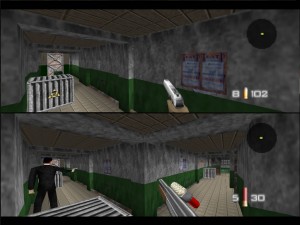 But it was the fast paced, frantic gunfights that really remain in the memory. Duels where two players are stalking one another, trying to finish each other off, only for a third player to blow them both away with a rocket launcher – it was those kinds of battles that made the game so compelling. The different game modes could lead players to play more tactically or mode offensively, and a great variety of styles were available. The speed of the game was always good – even with four players in the same location, and the level design was very clever – in that players were never too far from one another, but didn’t suffer from spawn kills to frequently. It is hard to describe the multiplayer mode, but for its time it was a revolution in home console play – this had never been done before – and it could be picked up and played so quickly, that the game became incredibly addictive – leading to huge commercial and critical successes – neither of which it was tipped for.
But it was the fast paced, frantic gunfights that really remain in the memory. Duels where two players are stalking one another, trying to finish each other off, only for a third player to blow them both away with a rocket launcher – it was those kinds of battles that made the game so compelling. The different game modes could lead players to play more tactically or mode offensively, and a great variety of styles were available. The speed of the game was always good – even with four players in the same location, and the level design was very clever – in that players were never too far from one another, but didn’t suffer from spawn kills to frequently. It is hard to describe the multiplayer mode, but for its time it was a revolution in home console play – this had never been done before – and it could be picked up and played so quickly, that the game became incredibly addictive – leading to huge commercial and critical successes – neither of which it was tipped for.
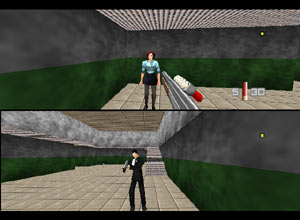 Playing the game now, you couldn’t say that it has aged particularly well. The controls feel too light and characters seem to float around the levels. The graphics are terribly blocky – especially when compared to the high definition visuals we are spoiled with nowadays. But what remains is the simple, plug and play idea that four friends can just sit down and play together immediately. In the current market where online co-operative play and multiplayer Deathmatches over networks are the main selling point of many games, Goldeneye 007 reminds us of a simpler era, when gamers would actually want to be spending time together in the same place and socialising at the same time as playing their game. The banter and competitive edge that was produced with four players being in the same room, all intent on killing one another and attaining the highest number of kills is a whole world away from modern multiplayer gaming. And whilst online multiplayer has enabled those who don’t live close to other players of a game – or don’t have enough control pads to support a big game – to play with other like-minded gamers. But the thrill and excitement of split-screen play has sadly fallen by the wayside. Goldeneye was both the first example of how console FPS games should be made, but also one of a short-lived breed. When a modern game does include split-screen play, it is a great addition, but something that is seen all too infrequently. With the surge in popularity of online gaming, will we ever see another multiplayer experience quite like Goldeneye?
Playing the game now, you couldn’t say that it has aged particularly well. The controls feel too light and characters seem to float around the levels. The graphics are terribly blocky – especially when compared to the high definition visuals we are spoiled with nowadays. But what remains is the simple, plug and play idea that four friends can just sit down and play together immediately. In the current market where online co-operative play and multiplayer Deathmatches over networks are the main selling point of many games, Goldeneye 007 reminds us of a simpler era, when gamers would actually want to be spending time together in the same place and socialising at the same time as playing their game. The banter and competitive edge that was produced with four players being in the same room, all intent on killing one another and attaining the highest number of kills is a whole world away from modern multiplayer gaming. And whilst online multiplayer has enabled those who don’t live close to other players of a game – or don’t have enough control pads to support a big game – to play with other like-minded gamers. But the thrill and excitement of split-screen play has sadly fallen by the wayside. Goldeneye was both the first example of how console FPS games should be made, but also one of a short-lived breed. When a modern game does include split-screen play, it is a great addition, but something that is seen all too infrequently. With the surge in popularity of online gaming, will we ever see another multiplayer experience quite like Goldeneye?
Goldeneye 007 is currently unavailable to purchase new, but can be bought second hand from sites such as eBay. Eurocom and Activision will be releasing their re-working of the Goldeneye title for Xbox 360 and PlayStation 3 on November 4th 2011. The God is a Geek Retro Corner is part of “Feature Friday” and will return on the first Friday of next month. You can see previous entries into the GodisaGeek Retro Corner by clicking here.





